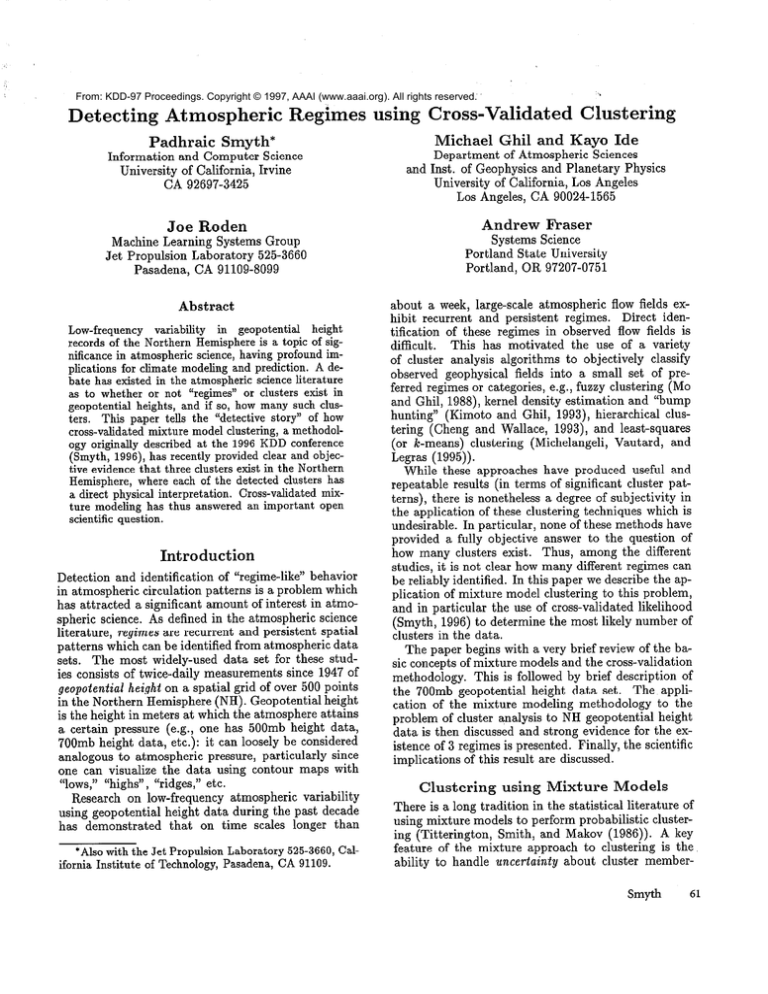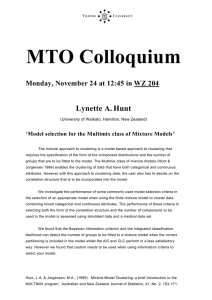
From: KDD-97 Proceedings. Copyright © 1997, AAAI (www.aaai.org). All rights reserved.
Detecting
Atmospheric
Regimes using Cross-Validated
Michael Ghil and Kayo Ide
Padhraic Smyth*
Information
and Computer
University
of California,
CA 92697-3425
Science
Irvine
Department
of Atmospheric
Sciences
and Inst. of Geophysics and Planetary
Physics
University of California, Los Angeles
Los Angeles, CA 90024-1565
Joe Roden
Andrew
Fraser
Systems Science
Portland State University
Portland,
OR 97207-0751
Machine Learning Systems Group
Jet Propulsion
Laboratory
525-3660
Pasadena,
CA 91109-8099
Abstract
Low-frequency
variability in geopotential
height
records of the Northern Hemisphere is a topic of significance in atmospheric science, having profound implications for climate modeling and prediction. A debate has existed in the atmospheric science literature
as to whether or not “regimes” or clusters exist in
geopotential heights, and if so, how many such clusters. This paper tells the “detective story” of how
cross-validated mixture model clustering, a methodology originahy described at the 1996 KDD conference
(Smyth, 1996), h as recently provided clear and objective evidence that three clusters exist in the Northern
Hemisphere, where each of the detected clusters has
a direct physical interpretation. Cross-validated mix^-^ture modeling has thus answered an iiiip0i;tAK.i upcu
scientific question.
Introduction
Detection and identification
of “regime-like” behavior
in atmospheric
circulation
patterns is a problem which
has attracted
a significant amount of interest in atmospheric science. As defined in the atmospheric
science
literature,
regimes are recurrent
and persistent
spatial
patterns which can be identified from atmospheric data
sets. The
mnnf. wldelv-nsed
. Y” _,.&__”
.J ---- data set for these studies consists of twice-daily measurements
since 1947 of
geopotential height on a spatial grid of over 500 points
in the Northern Hemisphere (NH). Geopotential
height
is the height in meters at which the atmosphere attains
a certain pressure (e.g., one has 500mb height data,
700mb height data, etc.): it can loosely be considered
analogous to atmospheric
pressure, particularly
since
one can visualize the data using contour maps with
“lows,” “highs” , “ridges,” etc.
Research on low-frequency
atmospheric
variability
using geopotential
height data during the past decade
has demonstrated
that on time scaies ionger than
*Also with the Jet Propulsion Laboratory 525-3660, California Institute of Technology, Pasadena, CA 91109.
Clustering
about a week, large-scale atmospheric
flow fields exhibit recurrent
and persistent
regimes.
Direct identification
of these regimes in observed flow fields is
rl;fGo,.1t
UllllbUl”.
‘l-‘
h;c
Illl”
hs.x
mntixrnt,wl
nf v2
II_
ill”“. .._“U”U t.hc=
“A&” IIPP
..a”” VL
v2riet;y
of cluster analysis algorithms
to objectively
classify
observed geophysical
fields into a small set of preferred regimes or categories, e.g., fuzzy clustering (MO
and Ghil, 1988), kernel density estimation
and “bump
hunting”
(Kimoto and Ghil, 1993), hierarchical
clustering (Cheng and Wallace, 1993), and least-squares
(or k-means) clustering
(Michelangeli,
Vautard,
and
Legras (1995)).
While these approaches
have produced
useful and
repeatable
results (in terms of significant
cluster patterns), there is nonetheless
a degree of subjectivity
in
the application
of these clustering techniques
which is
undesirable.
In particular,
none of these methods have
provided a fully objective answer to the question of
how many clusters exist. Thus, among the different
studies, it is not clear how many different regimes can
be reliably identified. In this paper we describe the application of mixture model clustering to this problem,
and in particular
the use of cross-validated
likelihood
(Smyth, 1996) to determine the most likely number of
clusters in the data.
The paper begins with a very brief review of the ba,:- ------~c^-~-:~c....,.
-,.-lA,.._?l
CL,.,,,,,
.rnl:rl,t;,,
blC c"Ilcapba
"1 IIIIzxblu~III"uI;‘3
auu
Irllcz
LI"UD-YcbIIua"I"II
methodology.
This is followed by brief description
of
the 700mb geopotential
height data set. The application of the mixture modeling methodology
to the
problem of cluster analysis to NH geopotential
height
data is then discussed and strong evidence for the existence of 3 regimes is presented.
Finally, the scientific
implications
of this result are discussed.
Clustering
There
..-:-,
uslllg
using
is a long tradition
,:..+....A
Il‘lAlJUIG
,,,4_1,
III"UI?IU
ing (Titterington,
feature
ability
Mixture
+n ,,,C,,>.m
IJ" pGrL"Lll,
Smith,
Models
in the statistical
literature
nnrrhnh;l;ot;e
~L"vcuurrru"rL.
and Makov
of
pl,,atp,._
.dIU""YI~
(1986)).
A key
of the mixture approach to clustering
is the
to handle tincertainty about cluster memberSmyth
61
ship, cluster locations and shapes, and the number of
clusters in a theoretically-sound
manner.
Let X be a d-dimensional
random variable and let
: represent a particular
value of _X, e.g., an observed
data vector with d components.
A finite mixture probability density function for X can be written as
f@)(@P)) =
&
ajgj (&9j)
‘500v
(1)
j=l
where k is the number
and each of the gj are the
The Bj are the parameters
ponent gj and the OIj are
component
j, where Cj
of components
in the model
component density functions.
associated with density comthe reiative “weights” for each
oj = 1 and oj > 0,l 5 j 5 k.
(P@) = (cY’1,. . .) a,$,&, . . . ,ek} denotes the set of parameters
for the overall mixture
model.
for example Titterington,
Smith, and Makov (1986).
Crossvalidated log-likelihood provides a practical and sound
way to estimate how many clusters k best fit a given
data set (Smyth, 1996).
The Northern
Geopotential
Hemisphere 700mb
Height Data Set
We analyzed the same data as has been used in most of
the other clustering studies on this topic (e.g., Kimoto
observations
of
and Ghil (1993)), namely, twice-daily
the NH 700-mb geopotential
heights on a loo x loo
diamond grid, compiled at NOAA’s Climate Analysis
Center. The data are subject to a number of specific
preprocessing
steps, each of which are considered desirable from an atmospheric
science viewpoint.
The original 541 grid points are thinned out to yield 358 grid
points. This “thinning”
removes some points north of
60” so that the resulting map has a more even distriFor each resulting
grid point,
bution of grid points.
a 5-day running average is applied to remove seasonal
effects.
The resulting
time series (one at each grid
point) are called height anomalies, in the sense that
the remaining
signal is the anomalous
departure from
seasonal trends.
A “winter” is defined as the 90 day
Opnllnn,-n ,C
Qnnmnl;do
ham;,knm
ucIyuxzII~~
“I ~~I”IIIcL.ll~D
LJ.z~jlLllllll~ T\n
“I1 nAromLn
uc.I..zIIIII~L 1-t
IUY 4
“I
each year. All analysis was performed on the winter
data, namely the 44 x 90 = 3960 days defined to be
within the winter periods from Dee 1st 1949 extending
through March 31st 1993. Non-winter
data has much
weaker persistence
patterns
and, thus, is typically excluded from analysis.
As is common practice in atmospheric
science, the
dimensionality
is reduced
via principal
component
analysis
of the anomaly
covariance
matrix
(a step
referred to as empirical orthogonal function analysis
science literaor EOF analysis in the atmospheric
ture).
We will use the atmospheric
science notation
of “EOFs” to refer to principal component
directions
in the rest of the paper.
Projections
used in the results described in this paper range from the first 2 to
the first 12 EOFs.
62
KDD-97
-15xl’
-1500
-1000
-500
EC&
5M)
Figure 1: Scatter plot of NH winter
jected into first 2 EOF dimensions
1000
anomalies
1500
pro-
The original 541 grid points for each time index are
reduced to a low-dimensional
projection
by this series
of preprocessing
steps. Figure 1 shows the 3960 data
points projected onto the first two EOFs. It is in this
low-dimensional
space that cluster analysis is typically
performed.
From a data analysis viewpoint
one may
well ask whether or not the results will be sensitive to
any of the preprocessing
steps performed above. One
way of addressing this is to find a way to compare cluster results both with and without preprocessing:
we
describe such a comparison later in the paper. It is also
important
to note, however, that while alternative
preprocessing steps might suggest themselves purely from
a data analysis viewpoint
(such as the use of other
projection
methods), it is important
to investigate
(as
described here) the application
of an objective clustering methodology
on data which is as similar as possible
to that used in previous studies.
Application
of Mixture
Clustering
Model
We applied
the mixture
model
cross-validation
methodology
(Smyth,
1996) on the two-dimensional
data set in Figure 1. In all experiments
the number of
cross-validation
partitions
was M = 20 and the fraction of data p contained in each test partition
was set
to 0.5. The number of clusters (mixture components)
was varied from k = 1 , . . .15. The log-likelihoods
for k > 6 were invariably
much lower than those for
k < 6 so for clarity only the results for k = 1, . . . ,6 are
presented.
The estimated
posterior probabilities
and
cross-validated
log-likelihoods
are tabulated
in Table
1. The posterior probabilities
indicate clear evidence
for 3 clusters, i.e., the cross-validation
estimate of the
posterior probability
for 3 clusters is effectively 1 and
all others are effectively zero.
Note that the absolute values of the log-likelihoods
Table 1: Cross-validated
partitions
of 44 winters.
log-likelihood
and estimated
k=l
Cross-validated
D-.C-.:,..
.r”*b~II”I
log-likelihood
,-.l.,.I.:l:+..
p”“v”“““y
posterior
k=2
probabilities,
as a function
k=4
k=3
k=5
of 6, from 20 random
k=6
-29164
-29153
-29137
-29148
-29156
-29165
0.0
0.0
I.0
0.0
0.0
0.0
*
:
f
i
:
Figure 2: Log-likelihood
of the test partition
data
on each cross-validation
iteration
relative to the loglikelihood of the Ic = 3 model for (from top) (a) k = 1,
(b) k = 2, (c) k = 4, (d), k = 5, and (e) k = 6.
Figure 3: Cross-validated
log-likelihoods
for k =
log-likelihood
of
1 >***, 6 relative to the cross-validated
the k = 3 model for 10 different randomly chosen crossvalidation partitions
are irrelevant-strictly
speaking, likelihood is only defined within an arbitrary
constant.
Figure 2 shows the
test log-likelihoods
on the 20 different cross-validation
partitions,
relative to the log-likelihood
on each partition of the k = 3 model (dotted line equal to zero).
Ic = 3 clearly dominates.
Note that for any particular partition k = 3 is not necessarily always the highest
likelihood model, but on average across the partitions
it is significantly
better than the other possible values
for k.
k = 1 (i.e., p(k = 1) M 1)). Thus, as the dimensionality increases beyond d = 6, the cross-validation
method does not provide any evidence to support
a
model more complex than a single Gaussian
bump.
This is to be expected since the number of parameters in a k-component
Gaussian mixture model grows
as kd2. Thus, since the total amount of data to fit the
models is fixed, as the dimensionality
d increases the
estimates of the more complex models are less reliable
and cannot be justified by the data. Cross-validation
will attempt to pick the best model which can be fit
to a finite set of data. If there are enough data, this
best model will correspond to the true model, while if
there are too few data (relative to thd conrplexity of the
models being fit), the method will be more conservative
and choose a simpler model which can be supported by
the data. Another interpretation
of this result is that
empirical support of the 3-component
model in higher
dimensions could require records on the order of a few
hundred years long, rather than the 44 years of data
^.%_..^..Cl.. aYalla”lc,
,..,:1..l.1I;ULLtxICIy
Robustness
Numerous
rametern
______
d-__-
runs
hilt.
__”
of the Results
on the same
wit.h
.._“__
data
with
the same pa-
different
_________ .i ~~.nrlnmlv-c.hnnp.n
___-___-__ J ---_I---
win&y
partitions
(with M = 20) always provided the same
result, namely, an estimated
posterior probability
of
p(k = 3) 2 0.999 in all cases.
The relative crossvalidated likelihoods
over 10 different runs are shown
in Figure 3.
We also investigated
the robustness of the method to
the dimensionality
of the EGF-space.
Tlne unfiltered
anomalies were projected into the first d EOF dimensions, d = 2,. . . , 12. As a function of the dimensionality d, the posterior probability
mass was concentrated
at k = 3 (i.e., p(k = 3) % 1) until d = 6, at which
point the mass “switched” to become concentrated
at
For the three-component
Gaussian model we investigated the variability in the physical grid maps obtained
across different numbers of EOF dimensions.
Note that
cluster centers in the EOF space can be ‘<mapped back”
to equivalent grid points in the original spatial grid to
smyth
63
Table 2: Pattern correlation
coefficients between maps
fitted using d EOF dimensions,
3 < d 5 12, and maps
fitted using 2 EOF dimensions.
EOF Dimensionality
d
r1
r2
r3
:
5
6
7
8
9
10
11
12
0.978
0.974
0.947
0.946
0.945
0.931
0.938
0.946
0.927
0.945
0.961
0.960
0.957
0.946
0.951
0.946
0.953
0.951
0.943
0.946
0.998
0.999
0.976
0.957
0.945
0.938
0.941
0.949
0.934
0.935
create spatial contour maps.
The unfiltered
anomai
lies were projected
into the first d EOF dimensions,
12 and a Gaussian
mixture model with 3
d = 3,...,
components
was fit to the data for each case. For each
value of d, 3 physical maps were obtained from the centers of the 3 Gaussians.
The pattern
correlations
(as
defined in Wallace and Cheng (1993), page 2676) were
then calculated between each of these maps (from d di,mensions) and the corresponding
maps obtained from 2
EOF dimensions.
The results are shown in Table 2. It
is clear that here is a very high correlation between the
2d EOF maps and maps obtained in up to 12 EOF dimensions.
One can conclude that the dimensionality
of
the EOF space does not affect the qualitative
patterns
of the physical maps in any significant
manner, using
the Gaussian mixture model clustering procedure.
-15001
-1500
1000
We ran AUTOCLASS
2.0 (a well-known Bayesian approximation
method for mixture modeling from NASA
Ames) on exactly the same data as described above.
The default version of AUTOCLASS
(full covariance
matrices)
returned
Ic = 3 as by far the most likely
choice for the number of clusters, i.e., no other Ic values had any significant
posterior probability.
For the
same data we also calculated
the BIC criterion which
penalizes the training log-likelihood
by an additive factor of -lc/2 log N. The BIC criterion was maximized
at k = 1 (by a substantial
margin).
This is consistent
with previous results which have reported that the BIC
criterion can be over-conservative.
Scientific
Interpretation
Result
of the E = 3
Given that there is strong evidence for 3 Gaussian clusters we fit a 3-component
Gaussian model to the entire set of 44 winters in the 2d EOF space (rather than
partitioning
into halves as before) and examine the re64
KDD-97
-500
E&l
500
1000
I-
DO
1
500-
2
&
egg
O
-500 :
Comparison with Bayesian and Penalized
Likelihood Techniques
-1ocQ
~
:
F@gy
-lOOO-
I
-‘?&o
1
-1ocnJ
-500
Al
500
1000
I
1500
Figure 4: (a) Scatter
plot of NH winter
anomalies projected
into first 2 EOF dimensions
with estimated means and covariance matrix shapes (ellipses)
superposed
as fitted by the EM procedure
with a 3component
Gaussian mixture model. (b) Contour plot
of the probability
density estimate provided by the 3component
Gaussian mixture
model fitted to the 2d
EOF data.
Figure 5: Height anomaly maps for the 3 cluster centers of the mixture model
(left: panels a, c and e) and of Cheng and Wallace’s (1993) hierarchical
cluster
model (right: panels b, d and f) which are reproduced
in Wallace (1996). See
text for details.
Panels b,d and f reproduced
by permission
of J. M. Wallace
and Springer-Verlag.
Smyth
65






